
Octopath Traveler II Review
I’ve had a rocky history with recent games by Square Enix’s Team Asano. The original Octopath Traveler, Bravely Default II, and Triangle Strategy were all full of potential, yet short of greatness. I’ve enjoyed dramatizing it as a “curse” of sorts, even if most of those titles were fun despite their unevenness. The only one I wasn’t able to truly get into was Octopath, and I’ve spent the last few years attempting to restart playthroughs to give it more chances to impress me.
Octopath Traveler II is the rare sequel that improves just about everything without changing too much of the original game’s core. It understands what made it work specifically for the people who fell in love with it, and it iterates on that with the clear intent to make them love this one even more. In addition to that, the sequel irons out the formula to make it more approachable for those who didn’t gel with the original. As someone in the latter camp all those years ago, I’ve found myself stunned at just how much this second visit has completely captured my full attention in the past few weeks.
Within the first few hours, after playing through your chosen protagonist’s introduction chapter, you’re given access to the game’s open world with complete freedom to explore it to your heart's content. There are some restrictions depending on who you start with, and it's a great idea to get at least four characters of the game’s total of eight recruited, but how you do this and the order you do it is entirely up to you. This, right here, is the main draw to the game. The world of Octopath II is one of my favorites in recent years; exploring it all will easily take players well over around 50-60 hours.
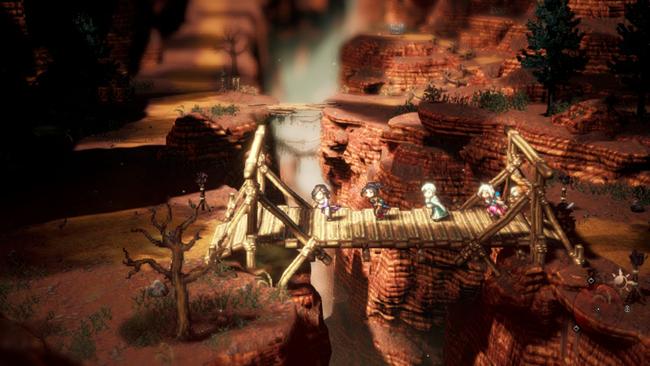
In my attempts to play the original Octopath Traveler, I had found myself bouncing off in the first 10 hours, finding many of the character’s introduction chapters and their motivations boring. Chapters seemed formulaic, drawn out, and just not that fun. I’d typically fall off after getting around 3 party members, and even after looking into the cast more online only two of them truly hooked me. This time around, just about every single character’s story felt both better-paced and written.
It is also rare for a chapter to go over two hours in length, and each chapter feels dense with story beats which kept me invested from start to finish. I’m not going to tell you that these stories are the zenith of the medium, but they’re very well written and often surprised me with where they went. The tone is frequently grim, exploring the darkness of humanity without presenting its ideas as cartoonish oversimplifications. There are some truly evil characters in this game, especially in Throné’s story, but they feel realistically evil and the game loves to delve into nuanced situations relating to them.
Where the true strengths of Octopath II lay are not in the story, even with me enjoying it as much as I did. The gameplay is what truly won me over, and everything they’ve done here just feels adjusted or tweaked enough to make it click this time. On paper, a lot of what Octopath II does feels just like what they did for the first game.
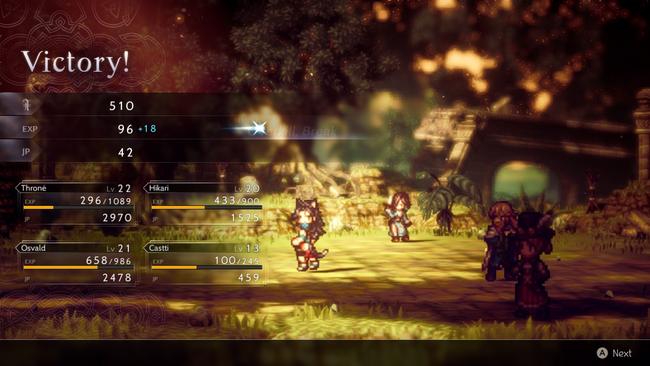
Path actions more or less boil down to four approaches: Acquiring items, learning about a person, recruiting them, or knocking them unconscious. Every character has around two of these available to them, which change depending on if it is currently day or night. For example, Throné can steal items during the day and ambush people at night. Temenos can recruit characters and interrogate them. Hikari can challenge NPCs to a fight to gain new abilities and bribe them to learn more about them. A fun new addition to compliment this is a button that lets you freely switch between the time of day on a whim, which can also be used to mix up the monsters you fight in the overworld.
I imagine when it came time to create a sequel to Octopath Traveler, the development team found it difficult to decide what bits of criticism to take to heart. I think the most common complaint was that the playable characters never interacted with each other’s stories. I too would voice this complaint often when discussing the game, and I think many people will be disappointed to hear this hasn’t been directly addressed. Having spent weeks playing Octopath II, however, I have a better understanding of why it was important to design the game this way, and I actually love it quite a lot.
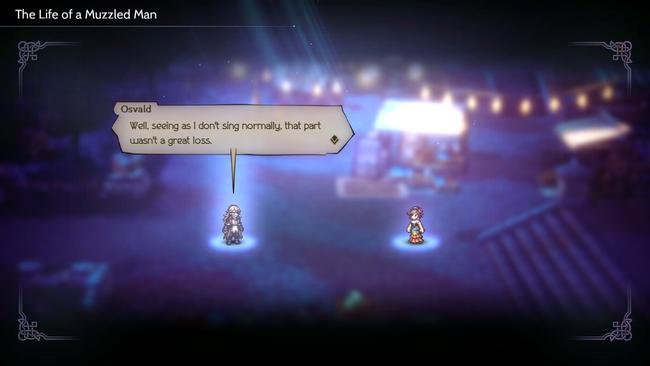
As I mentioned previously, Octopath Traveler is meant to be a structurally open game that values player freedom. The overall arrangement of eight individual characters with eight distinct storylines may not fit the more traditional and expected structure of a unified JRPG party and a unified goal, thus some concessions are made in order to fit that vision in terms of character dynamics. Maybe it took falling in love with the SaGa games - which share some common components - for me to begin to understand what Octopath was trying to do all along, but I think this was the right direction to take the sequel in. I'd rather not see Octopath change dramatically and risk its identity in order to conform to expectations it doesn’t try to meet. If you’re looking for linear, story-driven, party-centric RPGs, there are an abundance of them.
That said, the choice made to address this component of Octopath was to pair off each of the eight protagonists with another, and give each pair an ongoing side story. I don’t think these paired stories stand out as much better than the individual main story paths, but they’re still very charming and it's great to hear the cast help one another out solve little problems along the way. These are also entirely optional if players don’t wish to seek them out.
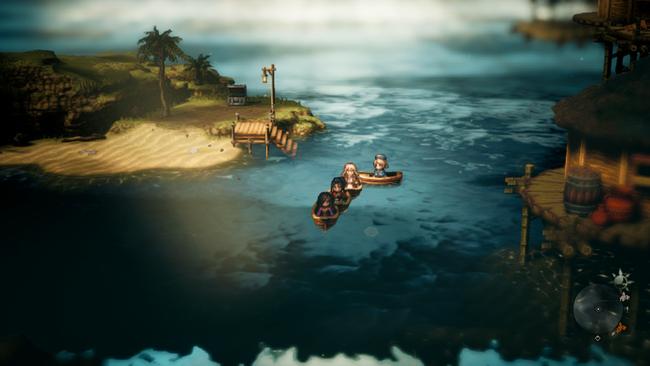
Even outside of the optional paired storylines, there is an abundance of extra content for players to find. Honestly, there’s an almost overwhelming amount of content in this game. You have your normal JRPG side quests, but much like the original game, they’re often hands-off and offer only vague hints at best on how to solve them. That’ll be a flaw for some, but when all the other side content in the game is equally mysterious and vague, I think it just works. One of the most peculiar moments in my playthrough was walking outside a random cave and noticing the environment and music seemed dark and murky. The music had changed, and my immediate first encounter soon after was an unknown and bizarre enemy that reset the world back to its original state once defeated. The game drew no explicit attention to this, and I was left giddy when I came across it. I feel like some games aren’t brave enough to be this mysterious anymore, and offer content that can be stumbled across by pure chance. I still haven’t figured out what caused this, but it set a precedent for me to uncover all of Octopath II’s secrets. There is a lot to uncover, and I feel like I’ve just scratched the surface.
While I adore just about every way Octopath Traveler II lets the player engage with it, there are some issues that were glaring to me. The first one is that the encounter rate is rather high. You can augment this with Job Class skills (take characters down the scholar path if you want this), but doing so could make my second major issue worse. Each character’s stories, along with every field map, have a recommended level. Players who have mastered these could likely get by under-leveled, but major story chapters on a character’s path will often jump rather high.
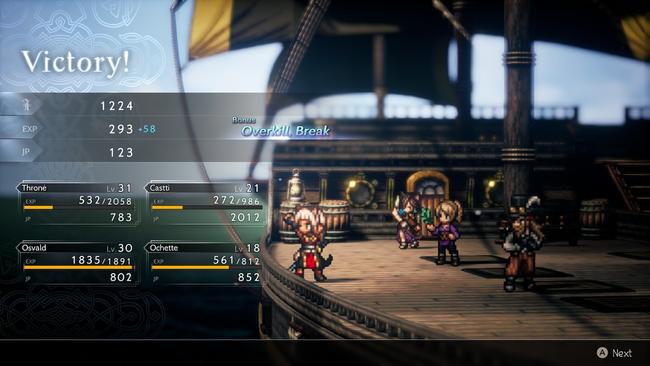
This level gating, especially the further you get into the game, could lead to some unfortunately long grinding sessions if you haven’t been frequently rotating your party. I made the mistake early of finding my favorite three characters to use in battle: Throné, Hikari, and Osvald. This left a fourth slot that I tried to rotate, but it wasn’t before long that a lot of my cast fell behind in experience. There is no passive EXP share for characters not in your active party, which honestly seems a bit outdated, and this could lead to tedium depending on how you play. Thankfully, with the world being as expansive as it is, with the addition of an explorable option accessible via a boat that can be purchased through a Partitio side quest, there are more than enough places to go to level up naturally along the way.
The saving grace of my main complaints is that combat is fun, even moreso than the original. It utilizes a mechanic inspired by the Bravely Default games that lets you stock up actions and use them in quick succession to score more hits or stronger special attacks. Combine this with an enemy break system that asks you to seek out and exploit weaknesses and an in-depth job system, and you have the recipe for a fantastic combat system. I don’t think much has changed here from the original, but tweaks under the hood seem to be made to make it flow better and it shows.
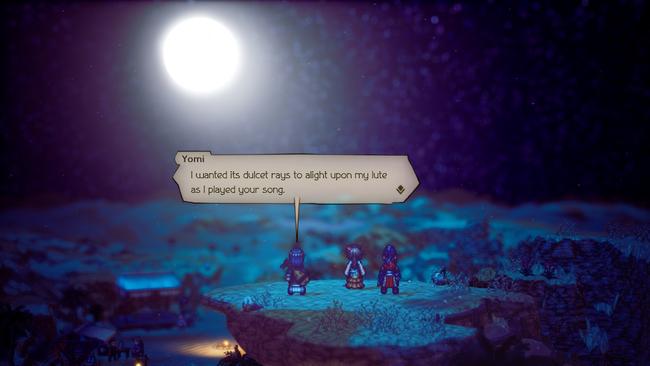
Finally, I think what was most impressive in my experience is that the Switch version is in a much better state than the last one. Even though this is now being released on several platforms at once, I was disappointed at first that there weren’t as many graphics options as Triangle Strategy on Switch. There’s only one option for graphic intensity, and it didn’t even feel like it changed much. However, after having plenty of time with the Switch version I don’t think it was that needed. They’ve toned down on the extreme amount of visual effects and increased the pool of colors used in the game’s palette.I’m happy this was addressed; it makes Octopath II one of the best-looking HD2D games to date. It seems like inspiration was taken from the recent Live A Live remake’s diverse aesthetics for each of the main stories, and I’m glad it seems like the right lessons were learned and applied here. Sprites can still be a bit blurry undocked, but not any more than Triangle Strategy and I feel it was cleaner than Octopath I. Overall, I don’t think playing this on Switch will be a bad experience for anyone who lacks a stronger console or PC.
Octopath Traveler II is a very confident sequel, knowing what worked with the original game and polishing those aspects. I love the cast, combat, and exploration. It's bigger and better. Simple as that. It doesn’t really take much explaining to sum up why this game is so good, and trust me I’ve tried. It takes a flawed yet enjoyable premise and improves on it so well that it's one of the better Square Enix games they’ve released in recent memory. Check out the demo, there’s really not much more I can say. It also offers one of my favorite open worlds I’ve explored in a game, a true achievement that is found in the intersection of retro throwback and a modern innovation.